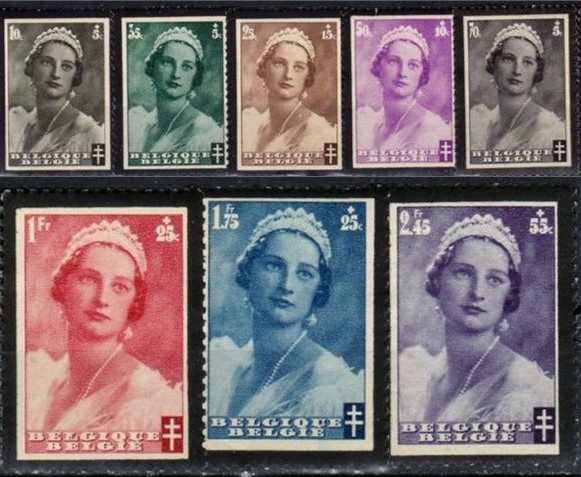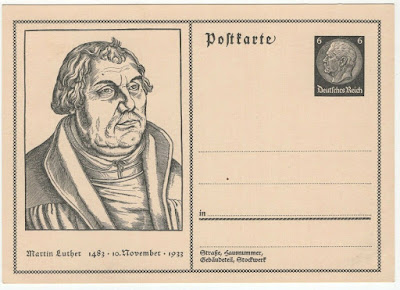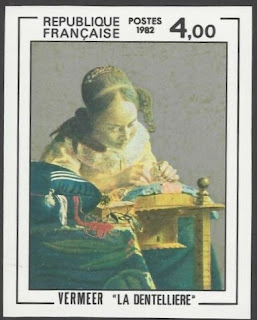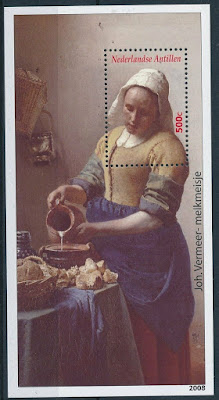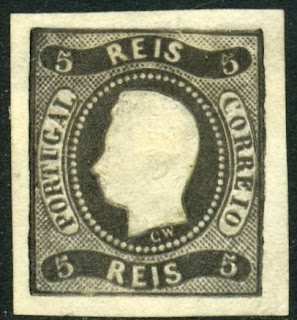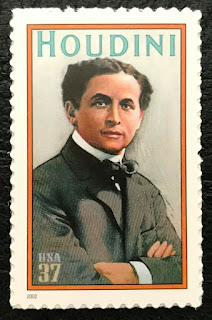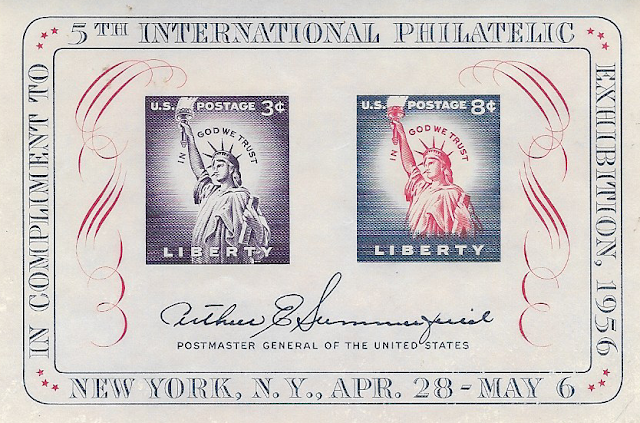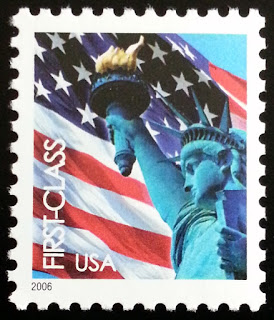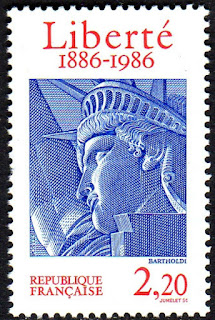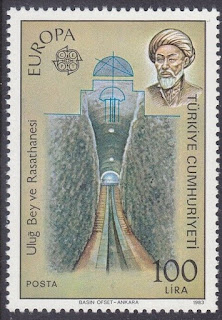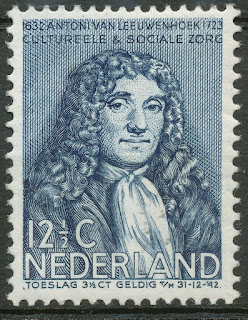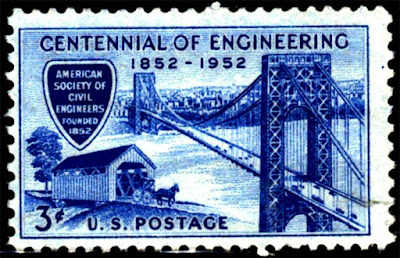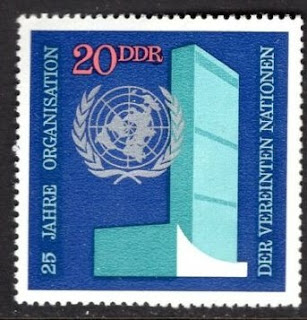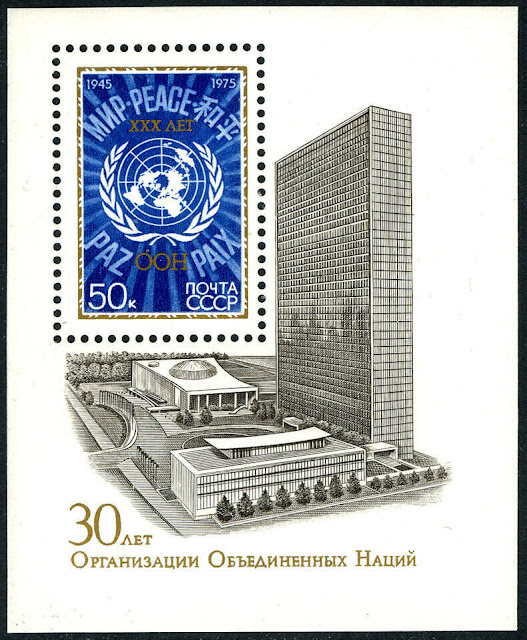Stamps from Russia depicting Catherine the Great
Tuesday, November 17, 2020
November 17th in stamps Joost van den Vondel, Catherine the Great, Astrid of Sweden, Nathaniel Palmer
Stamps from Russia depicting Catherine the Great
Saturday, October 31, 2020
October 31st in stamps Martin Luther posts his 95 Theses, Nevada statehood, Luís I of Portugal, Johannes Vermeer, Houdini, Adolf von Baeyer
Here are some events that happened on October 31st. It could be an event or a person that died or was born on that day
1517 – Protestant Reformation: Martin Luther posts his 95 Theses on the door of the Castle Church in Wittenberg.
Martin Luther (10 November 1483 – 18 February 1546) was a German professor of theology, composer, priest, monk, and a seminal figure in the Protestant Reformation.
Luther was ordained to the priesthood in 1507. He came to reject several teachings and practices of the Roman Catholic Church; in particular, he disputed the view on indulgences. Luther proposed an academic discussion of the practice and efficacy of indulgences in his Ninety-five Theses of 1517. His refusal to renounce all of his writings at the demand of Pope Leo X in 1520 and the Holy Roman Emperor Charles V at the Diet of Worms in 1521 resulted in his excommunication by the pope and condemnation as an outlaw by the Holy Roman Emperor.
Luther taught that salvation and, consequently, eternal life are not earned by good deeds but are received only as the free gift of God's grace through the believer's faith in Jesus Christ as redeemer from sin. His theology challenged the authority and office of the Pope by teaching that the Bible is the only source of divinely revealed knowledge, and opposed sacerdotalism by considering all baptized Christians to be a holy priesthood. Those who identify with these, and all of Luther's wider teachings, are called Lutherans, though Luther insisted on Christian or Evangelical (German: evangelisch) as the only acceptable names for individuals who professed Christ.
His translation of the Bible into the German vernacular (instead of Latin) made it more accessible to the laity, an event that had a tremendous impact on both the church and German culture. It fostered the development of a standard version of the German language, added several principles to the art of translation, and influenced the writing of an English translation, the Tyndale Bible. His hymns influenced the development of singing in Protestant churches. His marriage to Katharina von Bora, a former nun, set a model for the practice of clerical marriage, allowing Protestant clergy to marry.
In two of his later works, Luther expressed antagonistic views towards Jews. His rhetoric was not directed at Jews alone, but also towards Roman Catholics, Anabaptists, and nontrinitarian Christians. Luther died in 1546 with Pope Leo X's excommunication still effective.
Stamps from several countries depicting Martin Luther
1632 Born: Johannes Vermeer, Dutch painter (d. 1675)
Johannes Vermeer (October 1632 – December 1675) was a Dutch Baroque Period painter who specialized in domestic interior scenes of middle class life. He was a moderately successful provincial genre painter in his lifetime but evidently was not wealthy, leaving his wife and children in debt at his death, perhaps because he produced relatively few paintings.
Vermeer worked slowly and with great care, and frequently used very expensive pigments. He is particularly renowned for his masterly treatment and use of light in his work.
Vermeer painted mostly domestic interior scenes. "Almost all his paintings are apparently set in two smallish rooms in his house in Delft; they show the same furniture and decorations in various arrangements and they often portray the same people, mostly
He was recognized during his lifetime in Delft and The Hague, but his modest celebrity gave way to obscurity after his death. He was barely mentioned in Arnold Houbraken's major source book on 17th-century Dutch painting (Grand Theatre of Dutch Painters and Women Artists), and was thus omitted from subsequent surveys of Dutch art for nearly two centuries. In the 19th century, Vermeer was rediscovered by Gustav Friedrich Waagen and Théophile Thoré-Bürger, who published an essay attributing 66 pictures to him, although only 34 paintings are universally attributed to him today. Since that time, Vermeer's reputation has grown, and he is now acknowledged as one of the greatest painters of the Dutch Golden Age. Like some major Dutch Golden Age artists such as Frans Hals and Rembrandt, Vermeer never went abroad. And like Rembrandt, he was an avid art collector and dealer.
In 2008, American entrepreneur and inventor Tim Jenison developed the theory that Vermeer had used a camera obscura along with a "comparator mirror", which is similar in concept to a camera lucida but much simpler and makes it easy to match color values. He later modified the theory to simply involve a concave mirror and a comparator mirror. He spent the next five years testing his theory by attempting to re-create The Music Lesson himself using these tools, a process captured in the 2013 documentary film Tim's Vermeer.
In December 1675, Vermeer died after a short illness. He was buried in the Protestant Old Church on 15 December 1675.
Stamps from France, Netherlands and Netherlands Antilles depicting Vermeer's works
1835 Born: Adolf von Baeyer, German chemist and academic, Nobel Prize laureate (d. 1917)
Stamp issued by Guinea Bissau depicting Adolf von Baeyer
1838 Born: Luís I of Portugal (d. 1889)
Dom Luís I (31 October 1838 in Lisbon – 19 October 1889 in Cascais), known as The Popular (Portuguese: O Popular) was a member of the ruling House of Braganza, and King of Portugal from 1861 to 1889. The second son of Queen Maria II and her consort, King Ferdinand, he acceded to the throne upon the death of his elder brother King Pedro V.
Luís was a cultured man who wrote vernacular poetry, but had no distinguishing gifts in the political field into which he was thrust by the deaths of his brothers Pedro V and Fernando in 1861. Luís's domestic reign was a tedious and ineffective series of transitional governments called Rotativism formed at various times by the Progressistas (Liberals) and the Regeneradores (Conservatives), the party generally favoured by King Luís, who secured their long term in office after 1881. Despite a flirtation with the Spanish succession prior to the Franco-Prussian War of 1870–71, Luís's reign was otherwise one of domestic stagnation as Portugal fell ever further behind the nations of western Europe in terms of public education, political stability, technological progress and economic prosperity. In colonial affairs, Delagoa Bay was confirmed as a Portuguese possession in 1875, whilst Belgian activities in the Congo (1880s) and a British Ultimatum in 1890 denied Portugal a land link between Portuguese Angola and Portuguese Mozambique at the peak of the Scramble for Africa.
Stamps from Portugal and Madeira depicting Luís I
1864 – Nevada is admitted as the 36th U.S. state.
Nevada is a state in the Western United States. It is bordered by Oregon to the northwest, Idaho to the northeast, California to the west, Arizona to the southeast, and Utah to the east. Nevada is the 7th most extensive, the 32nd most populous, but the 9th least densely populated of the U.S. states. Nearly three-quarters of Nevada's people live in Clark County, which contains the Las Vegas–Paradise metropolitan area, including three of the state's four largest incorporated cities. Nevada's capital is Carson City.
Nevada is officially known as the "Silver State" because of the importance of silver to its history and economy. It is also known as the "Battle Born State" because it achieved statehood during the Civil War (the words "Battle Born" also appear on the state flag); as the "Sagebrush State", for the native plant of the same name; and as the "Sage-hen State".
Nevada is largely desert and semi-arid, much of it within the Great Basin. Areas south of the Great Basin are within the Mojave Desert, while Lake Tahoe and the Sierra Nevada lie on the western edge. About 86% of the state's land is managed by various jurisdictions of the U.S. federal government, both civilian and military.
Before European contact — and still today, American Indians of the Paiute, Shoshone, and Washoe tribes inhabited the land that is now Nevada. The first Europeans to explore the region were Spanish. They called the region Nevada (snowy) because of the snow which covered the mountains in winter like to Sierra Nevada in Spain. The area formed part of the Viceroyalty of New Spain, and became part of Mexico when it gained independence in 1821. The United States annexed the area in 1848 after its victory in the Mexican–American War, and it was incorporated as part of Utah Territory in 1850. The discovery of silver at the Comstock Lode in 1859 led to a population boom that became an impetus to the creation of Nevada Territory out of western Utah Territory in 1861. Nevada became the 36th state on October 31, 1864, as the second of two states added to the Union during the Civil War (the first being West Virginia).
US stamps commemorating Nevada's statehood
1926 Died: Harry Houdini, American magician and stuntman (b. 1874)
Harry Houdini (born Erik Weisz, later Ehrich Weiss or Harry Weiss; March 24, 1874 – October 31, 1926) was a Hungarian-born American illusionist and stunt performer, noted for his sensational escape acts. He first attracted notice in vaudeville in the United States and then as "Harry 'Handcuff' Houdini" on a tour of Europe, where he challenged police forces to keep him locked up. Soon he extended his repertoire to include chains, ropes slung from skyscrapers, straitjackets under water, and having to escape from and hold his breath inside a sealed milk can with water in it.
In 1904, thousands watched as he tried to escape from special handcuffs commissioned by London's Daily Mirror, keeping them in suspense for an hour. Another stunt saw him buried alive and only just able to claw himself to the surface, emerging in a state of near-breakdown. While many suspected that these escapes were faked, Houdini presented himself as the scourge of fake spiritualists. As President of the Society of American Magicians, he was keen to uphold professional standards and expose fraudulent artists. He was also quick to sue anyone who imitated his escape stunts.
Houdini made several movies but quit acting when it failed to bring in money. He was also a keen aviator and aimed to become the first man to fly a plane in Australia.
US stamp and FDC depicting Houdini
Wednesday, October 28, 2020
October 28th in stamps Erasmus, Cleveland dedicates the Statue of Liberty, First Czechoslovak Republic
Here are some events that happened on October 28th. It could be an event or a person that died or was born on that day
1466 Born: Erasmus, Dutch philosopher (d. 1536)
Desiderius Erasmus Roterodamus (28 October 1466 – 12 July 1536), known as Erasmus or Erasmus of Rotterdam, was a Dutch Christian humanist who is widely considered to have been the greatest scholar of the northern Renaissance. Originally trained as a Catholic priest, Erasmus was an important figure in classical scholarship who wrote in a pure Latin style.
Among humanists he enjoyed the sobriquet "Prince of the Humanists", and has been called "the crowning glory of the Christian humanists". Using humanist techniques for working on texts, he prepared important new Latin and Greek editions of the New Testament, which raised questions that would be influential in the Protestant Reformation and Catholic Counter-Reformation. He also wrote On Free Will,[5] In Praise of Folly, Handbook of a Christian Knight, On Civility in Children, Copia: Foundations of the Abundant Style, Julius Exclusus, and many other works
Below is a First Day Cover from the Netherlands and a stamp from Belgium depicting Erasmus
1886 – President Cleveland dedicates the Statue of Liberty.
The Statue of Liberty (Liberty Enlightening the World; French: La Liberté éclairant le monde) is a colossal neoclassical sculpture on Liberty Island in New York Harbor within New York City, in the United States. The copper statue, a gift from the people of France to the people of the United States, was designed by French sculptor Frédéric Auguste Bartholdi and its metal framework was built by Gustave Eiffel. The statue was dedicated on October 28, 1886.
The statue is a figure of Libertas, a robed Roman liberty goddess. She holds a torch above her head with her right hand, and in her left hand carries a tabula ansata inscribed JULY IV MDCCLXXVI (July 4, 1776 in Roman numerals), the date of the U.S. Declaration of Independence. A broken shackle and chain lie at her feet as she walks forward, commemorating the recent national abolition of slavery. After its dedication, the statue became an icon of freedom and of the United States, seen as a symbol of welcome to immigrants arriving by sea.
Bartholdi was inspired by a French law professor and politician, Édouard René de Laboulaye, who is said to have commented in 1865 that any monument raised to U.S. independence would properly be a joint project of the French and U.S. peoples. The Franco-Prussian War delayed progress until 1875, when Laboulaye proposed that the French finance the statue and the U.S. provide the site and build the pedestal. Bartholdi completed the head and the torch-bearing arm before the statue was fully designed, and these pieces were exhibited for publicity at international expositions.
The torch-bearing arm was displayed at the Centennial Exposition in Philadelphia in 1876, and in Madison Square Park in Manhattan from 1876 to 1882. Fundraising proved difficult, especially for the Americans, and by 1885 work on the pedestal was threatened by lack of funds. Publisher Joseph Pulitzer, of the New York World, started a drive for donations to finish the project and attracted more than 120,000 contributors, most of whom gave less than a dollar. The statue was built in France, shipped overseas in crates, and assembled on the completed pedestal on what was then called Bedloe's Island. The statue's completion was marked by New York's first ticker-tape parade and a dedication ceremony presided over by President Grover Cleveland.
The statue was administered by the United States Lighthouse Board until 1901 and then by the Department of War; since 1933 it has been maintained by the National Park Service as part of the Statue of Liberty National Monument, and is a major tourist attraction. The monument was temporarily closed from March 16, 2020 due to the COVID-19 pandemic until partially reopening on July 20, 2020. Public access to the balcony around the torch has been barred since 1916.
Stamps depicting the Statue of Liberty
1918 – First World War: Czech politicians peacefully take over the city of Prague, thus establishing the First Czechoslovak Republic.
The First Czechoslovak Republic (Czech: První československá republika, Slovak: Prvá česko-slovenská republika), often colloquially referred to as the First Republic (Czech: První Republika), was the first Czechoslovak state that existed from 1918 to 1938, dominated by ethnic Czechs and Slovaks, the country was commonly called Czechoslovakia (Czech and Slovak: Československo), a compound of Czech and Slovak; which gradually became the most widely used name for its successor states. It was composed of the territories of Austria-Hungary, having different system of administration of the former respective Austrian (Bohemia, Moravia, a small part of Silesia) and Hungarian territories (mostly Upper Hungary and Carpathian Ruthenia).
After 1933, Czechoslovakia remained the only de facto functioning democracy in Central Europe, organized as a parliamentary republic. Under pressure from its Sudeten German minority, supported by neighbouring Nazi Germany, Czechoslovakia was forced to cede its Sudetenland region to Germany on 1 October 1938 as part of the Munich Agreement. It also ceded southern parts of Slovakia and Carpathian Ruthenia to Hungary and the Zaolzie region in Silesia to Poland. This, in effect, ended the First Czechoslovak Republic. It was replaced by the Second Czechoslovak Republic, which lasted less than half a year before Germany occupied the rest of Czechoslovakia in March 1939.
Hradcany at Prague stamps issued in 1918 and 1919
Tuesday, October 27, 2020
October 27th in stamps Amsterdam. Michael Servetus, Niccolò Paganini, Theodore Roosevelt, Ulugh Beg
Here are some events that happened on October 27th. It could be an event or a person that died or was born on that day
1275 – Traditional founding of the city of Amsterdam.
Amsterdam is the capital and most populous city of the Netherlands with a population of 872,680 within the city proper, 1,380,872 in the urban area and 2,410,960 in the metropolitan area. Found within the province of North Holland, Amsterdam is colloquially referred to as the "Venice of the North", attributed by the large number of canals which form a UNESCO World Heritage Site.
After the floods of 1170 and 1173, locals near the river Amstel built a bridge over the river and a dam across it, giving its name to the village: "Aemstelredamme". The earliest recorded use of that name is in a document dated 27 October 1275, which exempted inhabitants of the village from paying bridge tolls to Count Floris V. This allowed the inhabitants of the village of Aemstelredamme to travel freely through the County of Holland, paying no tolls at bridges, locks and dams. The certificate describes the inhabitants as homines manentes apud Amestelledamme (people residing near Amestelledamme). By 1327, the name had developed into Aemsterdam.
Amsterdam's main attractions include its historic canals, the Rijksmuseum, the Van Gogh Museum, the Stedelijk Museum, Hermitage Amsterdam, the Concertgebouw, the Anne Frank House, the Scheepvaartmuseum, the Amsterdam Museum, the Heineken Experience, the Royal Palace of Amsterdam, Natura Artis Magistra, Hortus Botanicus Amsterdam, NEMO, the red-light district and many cannabis coffee shops. It drew more than 5 million international visitors in 2014. The city is also well known for its nightlife and festival activity; with several of its nightclubs (Melkweg, Paradiso) among the world's most famous. Primarily known for its artistic heritage, elaborate canal system and narrow houses with gabled façades; well-preserved legacies of the city's 17th-century Golden Age. These characteristics are arguably responsible for attracting millions of Amsterdam's visitors annually. Cycling is key to the city's character, and there are numerous bike paths.
The Amsterdam Stock Exchange is considered the oldest "modern" securities market stock exchange in the world. As the commercial capital of the Netherlands and one of the top financial centres in Europe, Amsterdam is considered an alpha world city by the Globalization and World Cities (GaWC) study group. The city is also the cultural capital of the Netherlands. Many large Dutch institutions have their headquarters in the city, including: the Philips conglomerate, AkzoNobel, Booking.com, TomTom, and ING. Moreover, many of the world's largest companies are based in Amsterdam or have established their European headquarters in the city, such as leading technology companies Uber, Netflix and Tesla. In 2012, Amsterdam was ranked the second best city to live in by the Economist Intelligence Unit (EIU) and 12th globally on quality of living for environment and infrastructure by Mercer. The city was ranked 4th place globally as top tech hub in the Savills Tech Cities 2019 report (2nd in Europe), and 3rd in innovation by Australian innovation agency 2thinknow in their Innovation Cities Index 2009. The Port of Amsterdam is the fifth largest in Europe. The KLM hub and Amsterdam's main airport: Schiphol, is the Netherlands' busiest airport as well as the third busiest in Europe and 11th busiest airport in the world. The Dutch capital is considered one of the most multicultural cities in the world, with at least 177 nationalities represented.
A few of Amsterdam's notable residents throughout history include: painters Rembrandt and Van Gogh, the diarist Anne Frank, and philosopher Baruch Spinoza.
Dutch stamps commemorating Amsterdam
1449 Died: Ulugh Beg, Persian astronomer and mathematician (b. 1394)
Mīrzā Muhammad Tāraghay bin Shāhrukh, better known as Ulugh Beg (22 March 1394 – 27 October 1449), was a Timurid sultan, as well as an astronomer and mathematician.
Ulugh Beg was notable for his work in astronomy-related mathematics, such as trigonometry and spherical geometry, as well as his general interests in the arts and intellectual activities. It is thought that he spoke five languages: Arabic, Persian, Turkic, Mongolian, and a small amount of Chinese. During his rule (first as a governor, then outright) the Timurid Empire achieved the cultural peak of the Timurid Renaissance through his attention and patronage. Samarkand was captured and given to Ulugh Beg by his father Shah Rukh.
He built the great Ulugh Beg Observatory in Samarkand between 1424 and 1429. It was considered by scholars to have been one of the finest observatories in the Islamic world at the time and the largest in Central Asia. Ulugh Beg was subsequently recognized as the most important observational astronomer from the 15th century by many scholars. He also built the Ulugh Beg Madrasah (1417–1420) in Samarkand and Bukhara, transforming the cities into cultural centers of learning in Central Asia.
However, Ulugh Beg's scientific expertise was not matched by his skills in governance. During his short reign, he failed to establish his power and authority. As a result, other rulers, including his family, took advantage of his lack of control, and he was subsequently overthrown and assassinated.
Stamps from Turkey and Uzbekistan depicting Ulugh Beg
1553 – Condemned as a heretic, Michael Servetus is burned at the stake just outside Geneva.
Michael Servetus (Spanish: Miguel Serveto as real name, French: Michel Servet), also known as Miguel Servet, Miguel de Villanueva, Michel Servet, Revés, or Michel de Villeneuve (Tudela, Navarre, 29 September 1509 or 1511 – 27 October 1553), was a Spanish theologian, physician, cartographer, and Renaissance humanist. He was the first European to correctly describe the function of pulmonary circulation, as discussed in Christianismi Restitutio (1553). He was a polymath versed in many sciences: mathematics, astronomy and meteorology, geography, human anatomy, medicine and pharmacology, as well as jurisprudence, translation, poetry and the scholarly study of the Bible in its original languages.
He is renowned in the history of several of these fields, particularly medicine. He participated in the Protestant Reformation, and later rejected the Trinity doctrine and mainstream Catholic Christology. After being condemned by Catholic authorities in France, he fled to Calvinist Geneva where he was burnt at the stake for heresy by order of the city's governing council.
Spanish stamps depicting Servetus
1782 Born: Niccolò Paganini, Italian violinist and composer (d. 1840)
Niccolò (or Nicolò) Paganini (27 October 1782 – 27 May 1840) was an Italian violinist, violist, guitarist, and composer. He was the most celebrated violin virtuoso of his time, and left his mark as one of the pillars of modern violin technique. His 24 Caprices for Solo Violin Op. 1 are among the best known of his compositions, and have served as an inspiration for many prominent composers.
Niccolò Paganini was born in Genoa, then capital of the Republic of Genoa, the third of the six children of Antonio and Teresa (née Bocciardo) Paganini. Paganini's father was an unsuccessful trader, but he managed to supplement his income by playing music on the mandolin. At the age of five, Paganini started learning the mandolin from his father and moved to the violin by the age of seven. His musical talents were quickly recognized, earning him numerous scholarships for violin lessons. The young Paganini studied under various local violinists, including Giovanni Servetto and Giacomo Costa, but his progress quickly outpaced their abilities. Paganini and his father then traveled to Parma to seek further guidance from Alessandro Rolla. But upon listening to Paganini's playing, Rolla immediately referred him to his own teacher, Ferdinando Paer and, later, Paer's own teacher, Gasparo Ghiretti. Though Paganini did not stay long with Paer or Ghiretti, the two had considerable influence on his composition style.
The French invaded northern Italy in March 1796, and Genoa was not spared. The Paganinis sought refuge in their country property in Romairone, near Bolzaneto. It was in this period that Paganini is thought to have developed his relationship with the guitar. He mastered the guitar, but preferred to play it in exclusively intimate, rather than public concerts. He later described the guitar as his "constant companion" on his concert tours. By 1800, Paganini and his father traveled to Livorno, where Paganini played in concerts and his father resumed his maritime work. In 1801, the 18-year-old Paganini was appointed first violin of the Republic of Lucca, but a substantial portion of his income came from freelancing. His fame as a violinist was matched only by his reputation as a gambler and womanizer.
In 1805, Lucca was annexed by Napoleonic France, and the region was ceded to Napoleon's sister, Elisa Baciocchi. Paganini became a violinist for the Baciocchi court, while giving private lessons to Elisa's husband, Felice. In 1807, Baciocchi became the Grand Duchess of Tuscany and her court was transferred to Florence. Paganini was part of the entourage, but, towards the end of 1809, he left Baciocchi to resume his freelance career.
For the next few years, Paganini returned to touring in the areas surrounding Parma and Genoa. Though he was very popular with the local audience, he was still not very well known in the rest of Europe. His first break came from an 1813 concert at La Scala in Milan. The concert was a great success. As a result, Paganini began to attract the attention of other prominent, though more conservative, musicians across Europe. His early encounters with Charles Philippe Lafont and Louis Spohr created intense rivalry. His concert activities, however, were still limited to Italy for the next few years.
In 1827, Pope Leo XII honoured Paganini with the Order of the Golden Spur. His fame spread across Europe with a concert tour that started in Vienna in August 1828, stopping in every major European city in Germany, Poland, and Bohemia until February 1831 in Strasbourg. This was followed by tours in Paris and Britain. His technical ability and his willingness to display it received much critical acclaim. In addition to his own compositions, theme and variations being the most popular, Paganini also performed modified versions of works (primarily concertos) written by his early contemporaries, such as Rodolphe Kreutzer and Giovanni Battista Viotti.
Paganini's travels also brought him into contact with eminent guitar virtuosi of the day, including Ferdinando Carulli in Paris and Mauro Giuliani in Vienna. But this experience did not inspire him to play public concerts with guitar, and even performances of his own guitar trios and quartets were private to the point of being behind closed doors.
Throughout his life, Paganini was no stranger to chronic illnesses. Although no definite medical proof exists, he was reputed to have been affected by Marfan syndrome or Ehlers–Danlos syndrome. In addition, his frequent concert schedule, as well as his extravagant lifestyle, took their toll on his health. He was diagnosed with syphilis as early as 1822, and his remedy, which included mercury and opium, came with serious physical and psychological side effects. In 1834, while still in Paris, he was treated for tuberculosis. Though his recovery was reasonably quick, after the illness his career was marred by frequent cancellations due to various health problems, from the common cold to depression, which lasted from days to months.
In September 1834, Paganini put an end to his concert career and returned to Genoa. Contrary to popular beliefs involving his wishing to keep his music and techniques secret, Paganini devoted his time to the publication of his compositions and violin methods. He accepted students, of whom two enjoyed moderate success: violinist Camillo Sivori and cellist Gaetano Ciandelli. Neither, however, considered Paganini helpful or inspirational. In 1835, Paganini returned to Parma, this time under the employ of Archduchess Marie Louise of Austria, Napoleon's second wife. He was in charge of reorganizing her court orchestra. However, he eventually conflicted with the players and court, so his visions never saw completion. In Paris, he befriended the 11-year-old Polish virtuoso Apollinaire de Kontski, giving him some lessons and a signed testimonial. It was widely put about, falsely, that Paganini was so impressed with de Kontski's skills that he bequeathed him his violins and manuscripts.
In 1836, Paganini returned to Paris to set up a casino. Its immediate failure left him in financial ruin, and he auctioned off his personal effects, including his musical instruments, to recoup his losses. At Christmas of 1838, he left Paris for Marseilles and, after a brief stay, travelled to Nice where his condition worsened. In May 1840, the Bishop of Nice sent Paganini a local parish priest to perform the last rites. Paganini assumed the sacrament was premature, and refused.
A week later, on 27 May 1840, Paganini died from internal hemorrhaging before a priest could be summoned. Because of this, and his widely rumored association with the devil, the Church denied his body a Catholic burial in Genoa. It took four years and an appeal to the Pope before the Church let his body be transported to Genoa, but it was still not buried. His body was finally buried in 1876, in a cemetery in Parma. In 1893, the Czech violinist František Ondříček persuaded Paganini's grandson, Attila, to allow a viewing of the violinist's body. After this episode, Paganini's body was finally reinterred in a new cemetery in Parma in 1896.
Stamps from Italy and Monaco depicting Paganini
1858 Born: Theodore Roosevelt, American colonel and politician, 26th President of the United States, Nobel Prize laureate (d. 1919)
US stamps depicting Teddy Roosevelt
Saturday, October 24, 2020
October 24th in stamps van Leeuwenhoek, Orville Wright, Harry Houdini, George Washington Bridge, United Nations Headquarters
Here are some events that happened on October 24th. It could be an event or a person that died or was born on that day
1632 Born: Antonie van Leeuwenhoek, Dutch biologist and microbiologist (d. 1723)
1799 Died: Carl Ditters von Dittersdorf, Austrian violinist and composer (b. 1739)
Carl Ditters von Dittersdorf (2 November 1739 – 24 October 1799) was an Austrian composer, violinist and silvologist.
Dittersdorf was born in the Laimgrube (now Mariahilf) district of Vienna, Austria, as August Carl Ditters. His father was a military tailor in the Austrian Imperial Army of Charles VI, for a number of German-speaking regiments. After retiring honorably from his military obligation, he was provided with royal letters of reference and a sinecure with the Imperial Theatre. In 1745, the six-year-old August Carl was introduced to the violin and his father's moderate financial position allowed him not only a good general education at a Jesuit school, but private tutelage in music, violin, French and religion. After leaving his first teacher, Carl studied violin with J. Ziegler, who by 1750, through his influence, secured his pupil's appointment as a violinist in the orchestra of the Benedictine church on the Freyung.
Ditters' early work laid the groundwork for his later more important compositions. His symphonic and chamber compositions greatly emphasize sensuous Italo-Austrian melody instead of motivic development, which is often entirely lacking even in his best works, quite unlike those of his greater peers Haydn and Mozart.
Even with these reservations, Dittersdorf was an important composer of the Classical era. After some early Italian opere buffe, he turned to writing German Singspiele instead, with Der Apotheker und der Doktor (1786, generally known today as Doktor und Apotheker) in particular being a tremendous success in his lifetime, playing in houses all over Europe and recorded almost two centuries later. Among his 120-or-so symphonies are twelve programmatic ones based on Ovid's Metamorphoses, although only six have survived (and have also been recorded). He also wrote oratorios, cantatas and concertos (among which are two for double bass and one for viola), string quartets and other chamber music, piano pieces and other miscellaneous works. His memoirs, Lebenbeschreibung ("Description of [My] Life"), were published in Leipzig in 1801. Some of his compositions, including the double bass concerto, were published in Leipzig by the Friedrich Hofmeister Musikverlag.
Austrian stamp and first day cover issued to commemorate 175 years since von Dittersdorf died
1911 – Orville Wright remains in the air nine minutes and 45 seconds in a glider at Kill Devil Hills, North Carolina.
1926 – Harry Houdini's last performance takes place at the Garrick Theatre in Detroit.
Harry Houdini (born Erik Weisz, later Ehrich Weiss or Harry Weiss; March 24, 1874 – October 31, 1926) was a Hungarian-born American illusionist and stunt performer, noted for his sensational escape acts. He first attracted notice in vaudeville in the United States and then as "Harry 'Handcuff' Houdini" on a tour of Europe, where he challenged police forces to keep him locked up. Soon he extended his repertoire to include chains, ropes slung from skyscrapers, straitjackets under water, and having to escape from and hold his breath inside a sealed milk can with water in it.
In 1904, thousands watched as he tried to escape from special handcuffs commissioned by London's Daily Mirror, keeping them in suspense for an hour. Another stunt saw him buried alive and only just able to claw himself to the surface, emerging in a state of near-breakdown. While many suspected that these escapes were faked, Houdini presented himself as the scourge of fake spiritualists. As President of the Society of American Magicians, he was keen to uphold professional standards and expose fraudulent artists. He was also quick to sue anyone who imitated his escape stunts.
Houdini made several movies but quit acting when it failed to bring in money. He was also a keen aviator and aimed to become the first man to fly a plane in Australia.
US stamp and FDC depicting Houdini
1931 – The George Washington Bridge opens to public traffic over the Hudson River.
The George Washington Bridge is a double-decked suspension bridge spanning the Hudson River, connecting the New York City borough of Manhattan with the New Jersey borough of Fort Lee. The bridge is named after George Washington, the first president of the United States. The George Washington Bridge is the world's busiest motor vehicle bridge, carrying over 103 million vehicles per year in 2016. It is owned by the Port Authority of New York and New Jersey, a bi-state government agency that operates infrastructure in the Port of New York and New Jersey. The George Washington Bridge is also informally known as the GW Bridge, the GWB, the GW, or the George, and was known as the Fort Lee Bridge or Hudson River Bridge during construction.
The idea of a bridge across the Hudson River was first proposed in 1906, but it was not until 1925 that the state legislatures of New York and New Jersey voted to allow for the planning and construction of such a bridge. Construction on the George Washington Bridge started in October 1927; the bridge was ceremonially dedicated on October 24, 1931, and opened to traffic the next day. The opening of the George Washington Bridge contributed to the development of Bergen County, New Jersey, in which Fort Lee is located. The upper deck was widened from six to eight lanes in 1946. The six-lane lower deck was constructed beneath the existing span from 1958 to 1962 because of increasing traffic flow.
The George Washington Bridge is an important travel corridor within the New York metropolitan area. It has an upper level that carries four lanes in each direction and a lower level with three lanes in each direction, for a total of 14 lanes of travel. The speed limit on the bridge is 45 mph (72 km/h). The bridge's upper level also carries pedestrian and bicycle traffic. Interstate 95 (I-95) and U.S. Route 1/9 (US 1/9, composed of US 1 and US 9) cross the river via the bridge. The New Jersey Turnpike (part of I-95) and U.S. Route 46 (US 46), which lie entirely within New Jersey, terminate halfway across the bridge at the state border with New York. At its eastern terminus in New York City, the bridge continues onto the Trans-Manhattan Expressway (part of I-95, connecting to the Cross Bronx Expressway).
The George Washington Bridge measures 4,760 feet (1,450 m) long and has a main span of 3,500 feet (1,100 m). It had the longest main bridge span in the world at the time of its opening and held that distinction until the opening of the Golden Gate Bridge in 1937.
US stamp depicting the George Washington Bridge
1949 – The cornerstone of the United Nations Headquarters is laid.
The United Nations is headquartered in New York City in a complex designed by a board of architects led by Wallace Harrison and built by the architectural firm Harrison & Abramovitz. The complex has served as the official headquarters of the United Nations since its completion in 1952. It is in the Turtle Bay neighborhood of Manhattan, on 17 to 18 acres (6.9 to 7.3 ha) of grounds overlooking the East River. Its borders are First Avenue on the west, East 42nd Street to the south, East 48th Street on the north, and the East River to the east. The term "Turtle Bay" is occasionally used as a metonym for the UN headquarters or for the United Nations as a whole.
The headquarters holds the seats of the principal organs of the UN, including the General Assembly and the Security Council, but excluding the International Court of Justice, which is seated in the Hague. The United Nations has three additional subsidiary regional headquarters, or headquarters districts. These were opened in Geneva (Switzerland) in 1946, Vienna (Austria) in 1980, and Nairobi (Kenya) in 1996. These adjunct offices help represent UN interests, facilitate diplomatic activities, and enjoy certain extraterritorial privileges, but do not contain the seats of major organs.
Although it is in New York City, the land occupied by the United Nations Headquarters and the spaces of buildings that it rents are under the sole administration of the United Nations and not the U.S. government. They are technically extraterritorial through a treaty agreement with the U.S. government. However, in exchange for local police, fire protection, and other services, the United Nations agrees to acknowledge most local, state, and federal laws.
None of the United Nations' 15 specialized agencies (such as UNESCO) are located at the headquarters. However, some "autonomous subsidiary organs", such as UNICEF, have their headquarters at the UNHQ.
Stamps from various countries depicting the United Nations Headquarters in New York City





